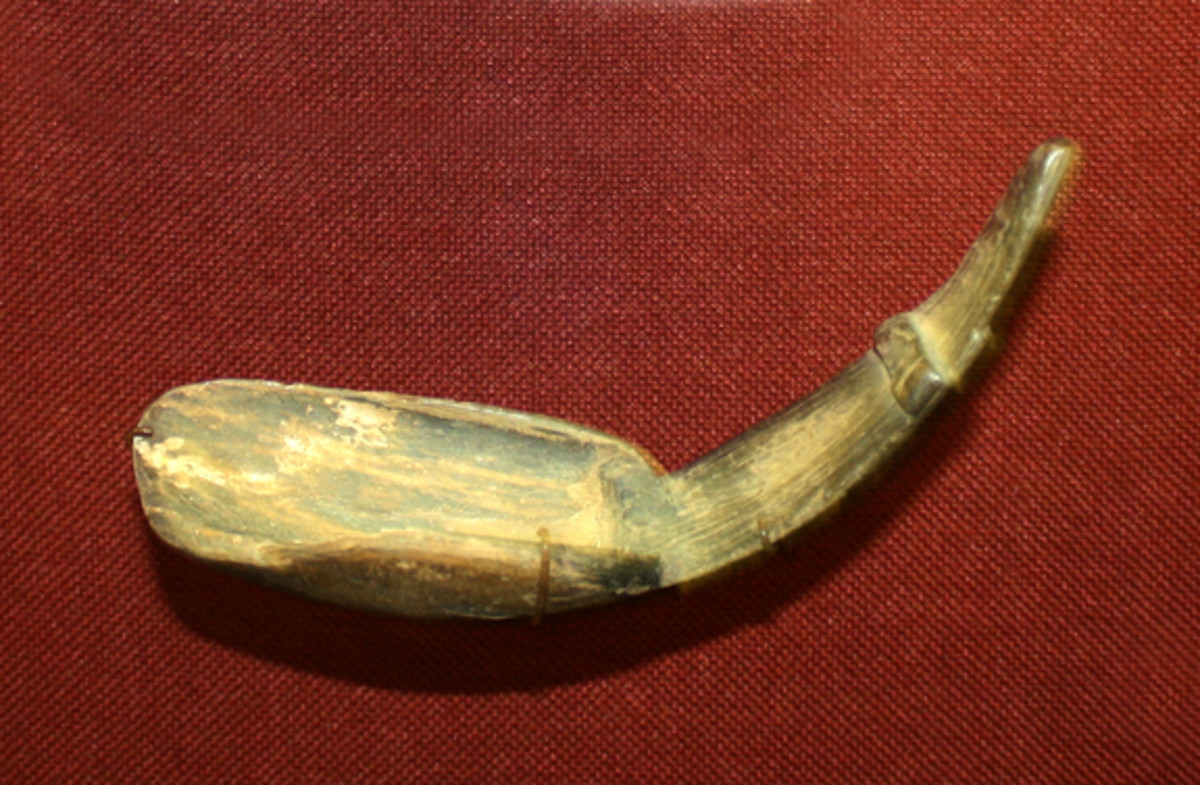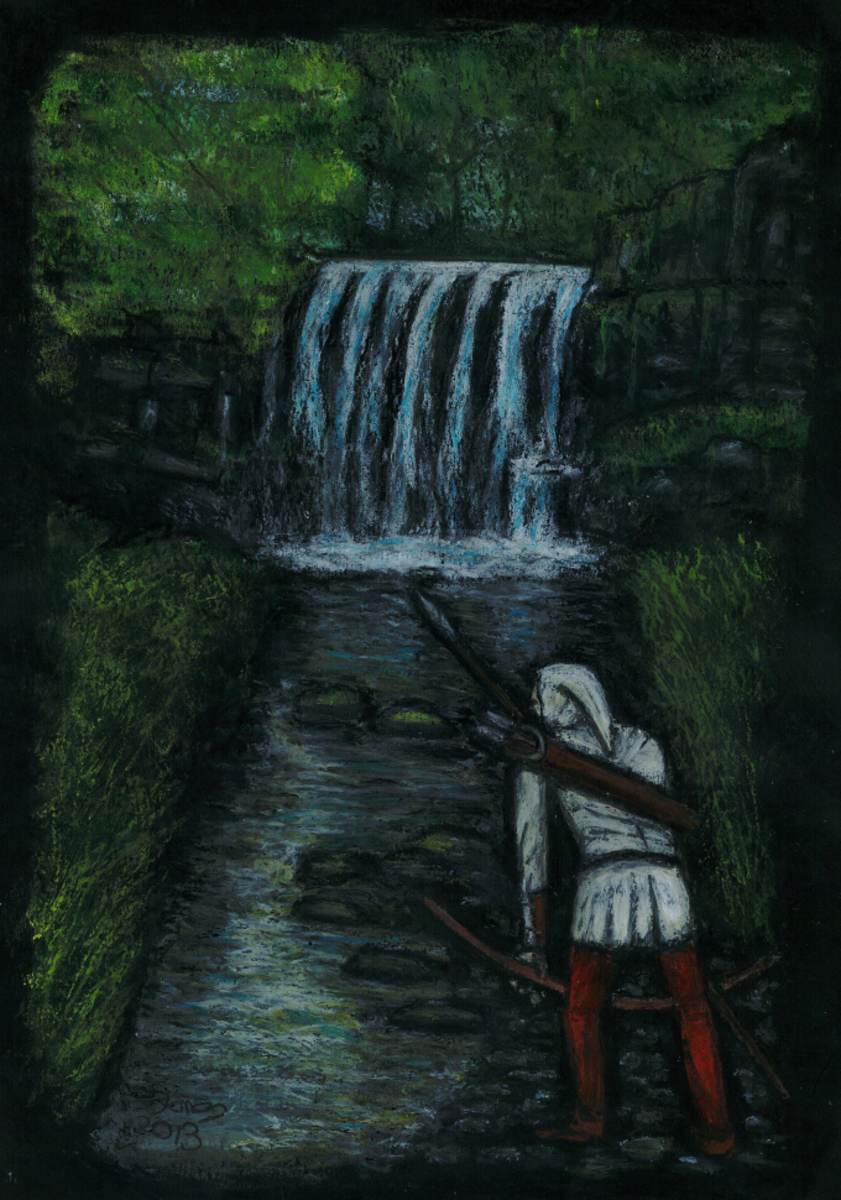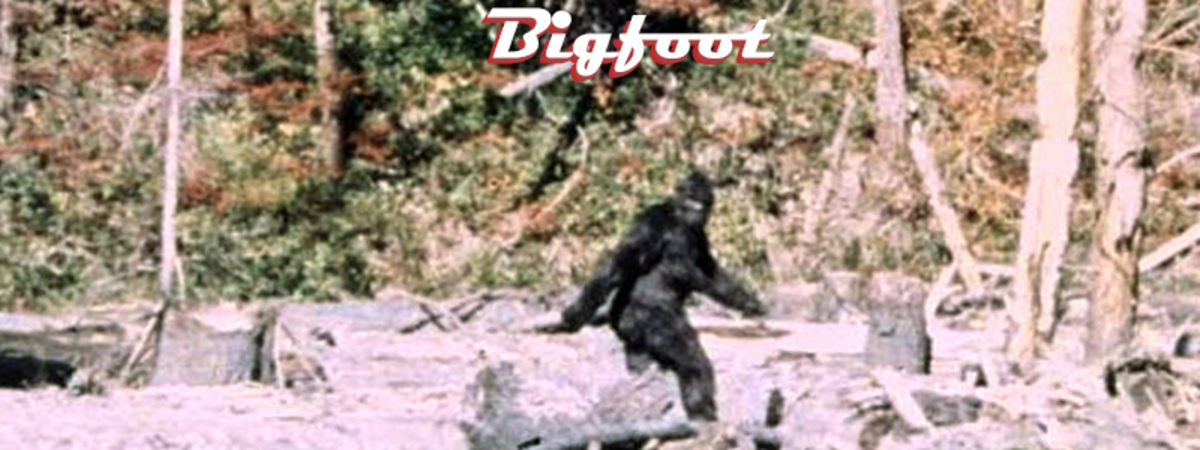Native American Wellness
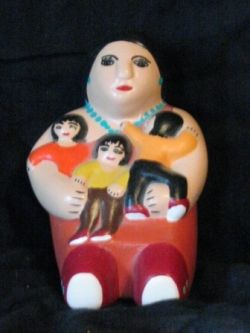
What is Native American Wellness?
Native Wellness is not just the absence of disease. It is living life in a circle, embracing the teachings of the old ways, where the individual is in balance with oneself, mind, body, spirit, and emotions. It means living in harmony with oneself, others, the Creator, and with all aspects of one's environment. It is having a sound cultural identity. Illness happens when this harmony or balance is broken.
This lens addresses some of the culture-specific issues surrounding quality of life in Native American populations. Please take a moment to read about this serious issue and pass the link around to help raise awareness. Thank you!
If you are of Native American, Alaskan Native, Native Hawaiian, or other indigenous background and would like to help make a difference in the delivery of health and mental health care for indigenous peoples, please consider volunteering as a research participant for the Native American wellness study. I need at least 182 participants!
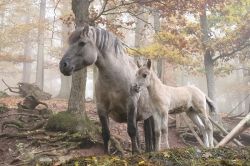
Introduction to the Study
Native Americans are a population in dire need of wellness attention. Age-adjusted death rates are greater for Native Americans than the rest of the U.S. population for alcoholism (740% higher), suicide (190% higher), homicide (180% higher), injuries (340 % higher), and tuberculosis (500% higher; IHS, 2001). In addition, Native people are at a higher risk for mental health and substance abuse problems than other ethnic groups (Portman, 2001; Provan & Carson, 2000), face some of the highest rates of diabetes and obesity in the world (Wharton & Hampl, 2004), and are unlikely to receive the treatment they need, improperly treated when they do receive it, and more likely than European Americans to leave treatment prematurely (Sue & Zane, 1994; USDHHS, 2000; U.S. Department of Health and Human Services, [USDHHS], 2001). Even when efforts are made to control sociodemographic factors, such as geographical location and socioeconomic status, disparities across race and ethnicity persist (USDHHS).
Compounding existing disparities is a lack of culturally appropriate, standardized assessment instruments for Native Americans that measure wellness and quality of life (QOL; Fiske, 2002; Weaver, 2002). In fact, few psychometric studies include Native American population samples in the standardization process, and even fewer studies directly address the question of whether current measures of QOL and wellness are effective or appropriate for Native populations (Fiske; Sobeck, Chapleski, & Fisher, 2003).
In response to these issues, the present study seeks to develop a culture-specific wellness instrument called the Native American Wellness Scale (NAWS). The development of the NAWS is grounded in a multidisciplinary body of literature that includes Native American Postcolonial Psychology (Duran & Duran, 1995), historical trauma theory (Brave Heart & DeBruyn, 1998; Brave Heart-Jordan & DeBruyn, 1995; Duran & Duran; Duran, Duran, & Brave Heart, 1998; Jilek, 1981; Solomon, Kotler, & Mikulincer, 1988), and the traditional indigenous model of the Native American Medicine Wheel (Cohen, 1998; Cross, 1998; Garrett, 1999; Meyers, Witmer, & Sweeney, 2000; Voss, Little Soldier, & Twiss, 1998; Weaver, 2002). When combined, these theories provide a comprehensive, contextual framework that operationalizes the dimensions necessary for effectively assessing overall wellness in Native populations.
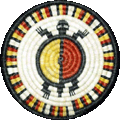
What is Native American Wellness?
Basic differences in wellness, healing, and illness concepts have been identified to exist between Native American and mainstream American cultures (Alvarado, 2005; Duran & Duran, 1995). For obvious reasons, this can create problems when measuring the construct across cultures. Wellness has traditionally been viewed from two different Western perspectives: (a) the clinical tradition, which operationalizes wellbeing through measures of pathology, and (b) the psychological tradition, which operationalizes wellbeing in terms of a person's subjective evaluation of lifestyle (Keyes, 1998). Along the Western scientific and explanatory continuum, there is premature death at one end of the spectrum and a high level of health at the other (Sarafino, 1994). As early as 1948, the World Health Organization defined wellness as "physical, mental, and social well-being, not merely the absence of disease" (WHO, 1958, p.1). Dunn (1961), who is considered by many to have pioneered the modern wellness movement, defined wellness as "an integrated method of functioning which is oriented toward maximizing the potential of which the individual is capable" (p. 4). Agreement on the multidimensional nature of wellness and QOL is evidenced in several domains commonly cited in the literature: Health-Related Quality of Life (HRQoL), social wellbeing, psychological wellbeing (e.g. Donovan, Sanson-Fisher, & Redman, 1989; Ferrell, Wisdom, & Wenzel; Padilla, Grant, & Martin), optimism, creativity, intrinsic motivation, and responsibility (e.g. Brown & Bedi, 2001; Ostir, Markides, Peek, & Goodwin, 2001), subjective wellbeing (e.g. Lawton, 1997; Dijkers, 1999), life satisfaction (e.g. Andrews & Withey, 1976), happiness (e.g. Deiner, 1984; Veenhoven 1988; Waterman, 1993), and spiritual wellbeing (e.g. Ashing-Giwa, 2005; Cella & Tulsky, 1990; Cohen, 1998; Donovan et al.).
On the other hand, previous research has indicated that Native cultures tend to equate wellness with wholeness, balance, and harmony (Cohen, 1998; Cross, 1998; Garrett & Garrett, 1994; Garrett, 1999; Locust, 1988; Meyers, Witmer, & Sweeney, 2000; Voss, Little Soldier, & Twiss, 1998; Weaver, 2002; Wing, Crow, and Thompson, 1995). For example, a commonly used metaphor for wellness among indigenous populations is the Medicine Wheel, known in psychology as the Jungian mandala (DaPice, 2006). The Medicine Wheel illustrates the interconnectedness of the four dimensions of wellbeing: physical, spiritual, emotional, and psychological (Cohen; Cross; Garrett & Garrett; Garrett; Locust; Meyers, Voss, Little Soldier, & Twiss; Weaver; Wing, Crow, and Thompson). According to Jung (1959), there are many different types of mandalas but they are all based on the squaring of a circle with the center point representing the self. Likewise, the Medicine Wheel is a circle divided into four quadrants, with each quadrant associated with the four sacred directions (e.g. West, North, East, South), and each direction corresponding to specific sacred teachings, meanings, spirits, life forms, elements of power, and aspects of wellbeing (e.g. physical, mental, spiritual, emotional). At the center of the Medicine Wheel is the self in balance; the place where all living things reside (Thin Elk, personal communication, 2005; Voss, Little Soldier, & Twiss).
Most Native American cultures integrate spiritual beliefs with beliefs about healing, health, and wellness (Garrett & Garrett, 1994; Voss, Little Soldier, & Twiss, 1999). According to the Association of American Indian Physicians (AAIP) member Dr. David Baines,
"Native Americans have a very different belief system with regards to illness, wellness, and healing…Wellness is not just the absence of disease. It is where the individual has harmony or balance with oneself, mind, body, and spirit, harmony with others and his/her surroundings or environment. Illness is allowed to come in when this harmony or balance is broken. This belief system recognizes how spiritual and emotional turmoil can lower one's defenses against illness. Healing is therefore the reinstatement of harmony. This can be done by the individual alone, or with the help of family, friends, and/or a spiritual healer. The spiritual healer has a special gift from the Creator to tap into his healing power to a great degree." (Baines, 1993, retrieved July 16, 2004 from http://www.aaip.com/).
As seen from the indigenous perspective, health is synonymous with wholeness. The ultimate source of this a wholeness is the Great Spirit, or Creator, a divine essence of which everything is a part. As such, health is understood only within the context of the whole, with spirituality a primary focus and aspect of the diagnosis and treatment of all afflictions (Cohen, 1998). Health involves the restoration of balance and harmony to body, mind, and spirit, and to relationships with family, community, and nature (Buchwald, Beals, & Manson, 2000).
Because a comprehensive theory of Native American wellness could not be located in the literature, the present study draws on cross disciplinary research and theoretical concepts that support characteristics related to optimal wellbeing and QOL in Native American populations. These theories and concepts include Native American Postcolonial Psychology (Duran & Duran, 1995), historical trauma theory (Brave Heart & DeBruyn, 1998; Brave Heart-Jordan & DeBruyn, 1995; Duran & Duran; Duran, Duran, & Brave Heart, 1998; Jilek, 1981; Solomon, Kotler, & Mikulincer, 1988), and the traditional indigenous model of the Native American Medicine Wheel (Cohen, 1998; Cross, 1998; Garrett, 1999; Meyers, Witmer, & Sweeney, 2000; Voss, Little Soldier, & Twiss, 1998; Weaver, 2002). Five influential aspects of Native American wellness result from this integration: physical wellbeing, psychological wellbeing, spiritual wellbeing, emotional wellbeing, and historical trauma (cultural wellbeing).
The Indian Theory of Existence
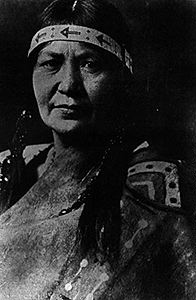
.... everything on the earth has a purpose, every disease an herb to cure it, and
every person a mission. This is the Indian theory of existence.
- Mourning Dove - (Humishuma) (Christine Quintasket)- Okanogan - Salish 1888-1936
Native American Postcolonial Psychology
One paradigm for understanding the problems associated with balanced and healthy living is Native American postcolonial psychology, which examines such issues through the perspectives of the culture (Duran & Duran, 1995; Gone, 2006). A central concept is that the psychological processes and life worlds of indigenous cultures are valid in their own right, and do not require comparison to some other legitimate culture, such as Western subjectivity. A similar concept adopted by anthropologists is cultural relativism (Boaz, 1963), a mindset that allows for the evaluation of cultures without comparison to one valid platform. In other words, both cultural relativism and postcolonial psychology provide a manner in which to avoid a Western, ethnocentric bias when observing other cultures (Deiner, 2005; Duran & Duran).
A postcolonial approach to Native American research necessitates an honest discussion about the process of colonization and the colonial mindset that continues to pervade society and the social sciences. The process of colonization refers to the psychological, social, cultural, and physical processes and effects of an imposing society on other lifeworlds (Duran, Duran, & Yellowhorse-Brave Heart, 1998). When this occurs, the primary concern of the colonizer is the concept of manifest destiny. Manifest destiny is the belief that the Caucasian race has the preordained right to expand its borders over entire continents and to control and populate as they see fit, even if it means the extermination, subjugation, oppression, and forced assimilation of whole societies into the culture of the colonizer's for the supposed benefit of humankind (see Berkhofer, 1978 for an in depth historical analysis of the colonization process and associated national policies that govern White imperial racist thought and behavior towards the indigenous peoples of the Americas).
Great Native American Psychology Stuff on Amazon
New Native American Wellness Link List
- WELLNESS HEALTHY LIVING: wellness inc,wellness information
... sports and wellness nutritional 20health 20 26 20wellness 20company 22. san ... www.ojasyogawellness.com unitedhealthwellness native american indian ... - Foundations of Wellness : The Basics for Staying Healthy
This guide offers you a headstart on the road to wellness with specific insights on the subjects of nutrition, longevity, and fitness. ... - wellness institute
The mission of the Native Wellness Institute is to foster the well-being of Native people through ... Director of the Native Wellness Institute. ... - Tribal College Journal of American Indian Higher Education
10 Introduction: Tribal colleges build Native wellness. 12 Traditional Assiniboine family values: Let us bring back something beautiful ... - "My Spirit Took Care of Me"
Turtle Island Native Wellness Study:. Urban American Indian Identity, Alcohol Use, and HIV Risks. Karina Walters, PI [7R29AA12010 1999-2003] ... - Aboriginal health Healing and Wellness Health traditional medicine ...
Welcome and thanks for visiting Turtle Island Native Network Your best online source for Aboriginal news Healing and Wellness News and Information ... - LookSmart's Furl - View Item - Native American Wellness
http://www.nativewellness.info/. Copyright 2007 LookSmart, Ltd. - About Us Privacy Policy Terms of Service Advertise with Us ... - Home of the The Native American Wellness Scale (NAWS)
The Native American Wellness Scale (NAWS): A multidimensional quality of life measure for indigenous populations.
What is Historical Trauma?
Historical trauma refers to the cumulative and collective psychological wounding over the lifespan and across generations in reaction to massive group trauma experiences such as genocide (Brave Heart; Duran & Duran, 1995; Niederland, 1989). Historically traumatic experiences (i.e. genocide, oppression, racism, forced geographic location, and federal boarding school mandates), behaviors related to coping with such experiences (i.e. substance abuse, and interpersonal violence), and conditions resulting from living within the context of such experiences (i.e. poverty, illiteracy, unemployment, health problems, internalized oppression, and mental illness), are directly related to quality of life and wellbeing, and help to create a contextual framework into which physical, mental, spiritual, emotional, and cultural variables interact to form an overall model of Native American wellness.
In keeping with the postcolonial paradigm, an honest discussion of quality of life issues as they pertain to Native American populations requires acknowledging the present subordinate status of contemporary Native peoples as inherited from the hostile social and political climate of previous generations. The colonization process as it has affected Native peoples includes the implementation of American genocidal policies, such as mass-execution, biological warfare, forced removal from homelands, incarceration, indoctrination of nonindigenous values through boarding school mandates, forced surgical sterilization of Native women, and the prevention of religious practices (Brave Heart & DeBruyn, 1998; Duran & Duran, 1995; Duran, Duran, & Braveheart, 1998; Poupart, 2003). Although it is impossible to determine the precise number of original indigenous inhabitants at the point of European contact, scholarly estimates range anywhere from two to 15 million indigenous people as having suffered from European genocidal acts over the period of four centuries (Rummel, 1994). For example, the French successfully exterminated the Mississippi River Natchez and Wisconsin Foxes in the 1730s; the Puritans of Massachusetts and Connecticut attempted to execute the Pequots of Connecticut in 1636 to 1637; the English attempted to exterminate the Powhatan chiefdom in Virginia in 1622 (Axtell, 1993); California’s first governor called for a “war of extinction” against the California Indians in 1850 which resulted in the massacre of numerous California Indian tribes (Elliot, 1995); the United States army massacred Black Kettle’s Cheyenne River band at Sand Creek in 1864 and the Nez Perce and Walla Walla in the 1870’s; and more than 150 Lakota men, women, and children were murdered by the United States army during the Wounded Knee massacre of 1890 (Lymon, 1993). One of the most documented incidences of deliberate and calculated acts of biological warfare against Native peoples in the Americas occurred in 1763 during Pontiac’s Rebellion, when the commander of the British army gave Native Americans representatives two blankets and a handkerchief infected with smallpox (d’Errico, 2006; Waldman, 1985).
From Wakan-Tanka,
the Great Mystery, comes all power. It is from Wakan-Tanka that the holy man has wisdom and the power to heal and make holy charms. Man knows that all healing plants are given by Wakan-Tanka, therefore they are holy. So too is the buffalo holy, because it is the gift of Wakan-Tanka.
Flat-Iron (Maza Blaska Oglala Sioux Chief)
Miracle, the Sacred White Buffalo
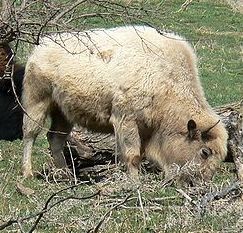
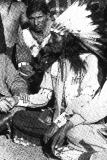
The Sacred Circle
We cannot all sit on the same side of the Fire. A Council Fire forms a circle, not a line or a square. When we move to the side, we still sit at the Fire with our Brothers and Sisters, but as we move away from one we move toward another. The circle, like the Dream Hoop, brings us ever back to where we start. Any time words of respect and love are spoken, they will return as given. A harsh word runs forever in the circle, eventually vanishing from the wear against itself. Love settles within the Circle, embracing it and thereby lasting forever, turning within itself. The Medicine Wheel is the circle of life (sometimes referred to as the Sacred Hoop). Starting with birth and continuing throughout our lives until death, when we have gone full circle. The Medicine wheel has four Direction, each direction offering it's own lessons, color, and animal guide. There are two paths shown which cross in the center, at which point for me is the heart (for when you work from your heart, you can reach all directions). The path from East to West is the path of spirits, (the Blue Road) the path from South to North is our physical Walk (the Red Road ).
East - beginnings, purity, family, innocence, amazement of Life
South - youth - passions of life, friendships, self-control
West - Adulthood - solitude, stillness, going inside oneself, reflection
North - Place of the Ancient Ones who have gone over - place of wisdom
Above - Freedom of mind, body, spirit
Below - Nurturing, Mother, life
- Luther Standing Bear, Oglala Sioux 1868-1937
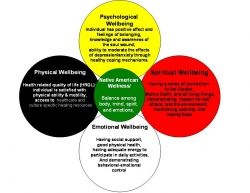
The Native American Wellness Model
The Native American Wellness Model (Alvarado, 2005) is a contextual model that acknowledges the sociohistorical context in which Native American people are situated in contemporary society (Duran, Duran, & Yellowhorse-Braveheart, 1998; Garrett & Garrett, 2002; Strickland, Squeoch, & Chrisman, 1999; Walters & Simoni, 2002). This model is grounded in Native American postcolonial psychology, a paradigm that accepts "knowledge from differing cosmologies as valid in their own right, without having to adhere to a separate cultural body for legitimacy" (Duran & Duran, 1995, p. 6). It is an intertribal, cross-indigenous model that focuses on the commonalities amongst tribal groups making it an inclusive perspective as opposed to an exclusive one, and provides a balanced perspective by focusing on strengths and resiliencies as opposed to a solely deficit approach.
Seven major causal factors contributing to wellness or unwellness and ten contextual factors are identified in the Native American Model that support the notion that Native Americans are uniquely situated in society as a colonized, yet resilient people, and that this situational status has a direct effect on well-being (Alvarado, 2005). The Native American Wellness Scale (NAWS) includes key dimensions of wellness that do not exist on current psychometric instruments; thus, punctuating the need for an integrated, holistic measure. Identity repertoires, loss of language and culture, and individual and community relationship to the environment, for example, are critical aspects of Native American wellness that are not reflected on existing quality of life measures (Alvarado).
At the center of the Native American Wellness Model is wellness and unwellness. Wellness is evidenced by sobriety, harmonious relationships with self, others, the natural environment, and the Creator, spiritual contentment, and living a spiritual lifestyle. Unwellness occurs when this balance is disrupted, and is indicated by the presence of spiritual distress, conflictual relationships, depression, violence, incest, inebriation, and unmanageability of daily stressors (Alvarado, 2005). In addition to highlighting major contextual factors affecting wellness and well-being, the Native American Wellness model identifies several action and intervention strategies that can be employed to enhance wellness, and suggests the probable consequences of the recommended interventions.
Treat the earth well:
it was not given to you by your parents, it was loaned to you by your children. We do not inherit the Earth from our Ancestors, we borrow it from our Children.
Ancient Indian Proverb
We, the great mass of the people think only of the
love we have for our land, we do love the land
where we were brought up. We will never let our hold
to this land go, to let it go it will be like throwing
away our mother that gave us birth.
Letter from Aitooweyah to John Ross,
Principal Chief of the Cherokees.
Great Native American Stuff on Amazon
Make Your Own Page Like This and Earn $$$
Got something to say?
Content Protection
You cannot re-publish this content elsewhere without crediting me (Voodoomama aka Denise Alvarado) as the owner and originator. Except where otherwise noted, the content is mine, written by me, and I own it.
This work is licensed under a
Creative Commons Attribution-Noncommercial-No Derivative Works 3.0 License.
Do you like this lens? Do you hate it? Comments and suggestions are welcome!












